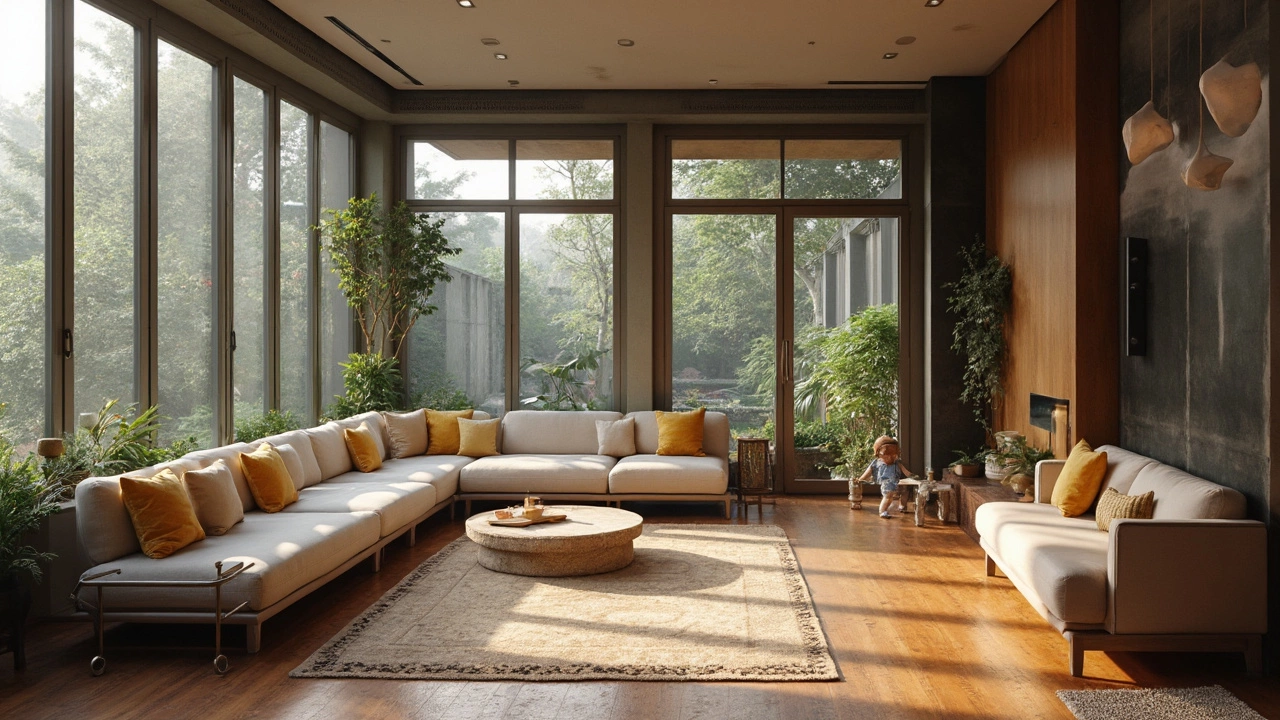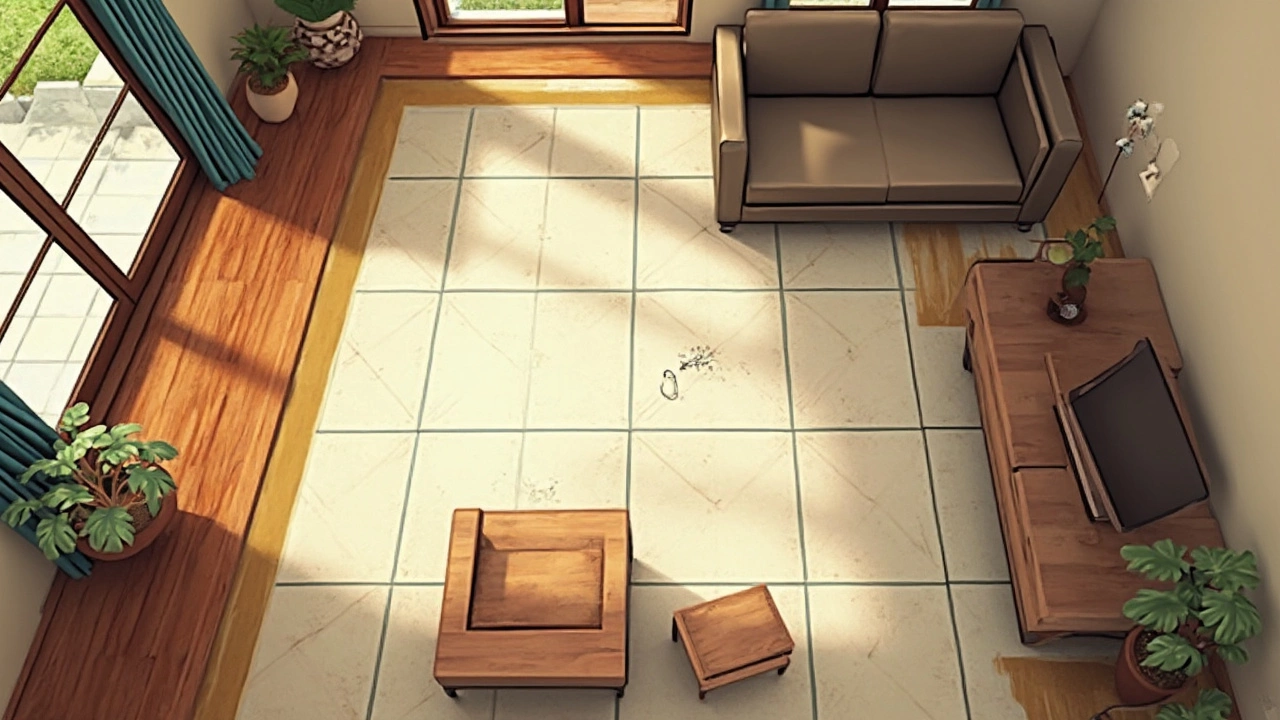Flooring vs. Furniture: Should Your Floors Be Lighter or Darker?

Ever stood in your living room, eyeing your sofa and floors, wondering if they look weird together? You’re not alone. The whole light floor vs. dark furniture debate trips up way more people than you’d guess. And yeah, your choices here change how inviting your place feels—or don’t.
Forget what’s trending for a second. The real question is how you want the space to look and work for you. Dark floors can ground a room and make furniture pop. Light floors can open things up and keep the vibe relaxed. But it’s not just about ‘nice or not nice.’ It comes down to daily life—what hides scratches, what shows dust, how often you actually clean, that kind of thing.
Grab some painter’s tape or an old rug and play around before you buy. Sometimes, it’s the only way to know if you love the look—or if it feels totally off. There’s no rule you have to follow, just a handful of smart tricks and real-life hacks that make the outcome way less stressful.
- The Visual Effect of Light and Dark
- Practical Pros and Cons
- Matching Styles Without Getting Boring
- How to Handle Different Room Sizes and Lighting
- Real-Life Tips for Mixing and Matching
The Visual Effect of Light and Dark
If you’ve ever wondered why some rooms feel huge and happy while others feel cozy or moody, it’s not just the furniture—it’s the flooring color and how it plays off what’s in the room. Here’s the deal: lighter floors reflect more light. That means they make a space feel bigger and brighter, which is a lifesaver in smaller rooms or anywhere that doesn’t get a ton of sun. Lighter tones—think pale oak or maple—tend to give off an airy and open vibe, nudging the focus upward and making everything feel less cramped.
On the flip side, darker furniture and floors absorb light. This grounds the space and brings a sense of warmth and envelope—you know, those homey, sit-back-and-chill spots. A deep walnut or espresso floor can totally transform a giant open-plan area, making it way less intimidating and giving big furniture real presence. But in small or dim rooms, it can look heavy fast unless you balance it out with lighter walls or décor.
One handy way to visualize? Look at restaurants and hotels. Super-bright spots usually rock lighter floors for that clean, welcoming feel. The more luxurious, cocoon-like spaces almost always use dark finishes to set the mood. It’s the same trick you can use at home.
If you like numbers, check this out:
| Floor Color | Perceived Room Size | Best For |
|---|---|---|
| Light | Looks up to 20% larger | Small rooms, low ceilings, less sunlight |
| Dark | Feels up to 15% smaller (but cozier) | Large rooms, open layouts |
Bottom line: if you want to draw attention upward and keep things open, lighter floors usually win. If you’d rather make a statement or anchor big pieces—especially darker furniture—then rich, deep floors have your back. Just don’t forget, the mix is usually what makes a room feel designed and not just thrown together.
Practical Pros and Cons
Choosing between light floors and dark furniture (or the other way around) isn’t just about looks. Day-to-day life with these choices has its ups and downs, and a few surprises people often miss.
Light flooring makes rooms look bigger and airier, especially if the walls are also light. If you hate seeing dust or pet hair, lighter floors have your back—they hide lint and crumbs way better than dark wood. But here’s the catch: dark scuffs, shoe marks, and coffee spills stick out. If you wear shoes inside or have dogs, you might be wiping up marks more than you want.
Dark flooring is great at hiding muddy footprints and everyday scratches. Perfect if you have kids or you’re not a fan of daily cleaning marathons. The downside? Every speck of dust and every pet hair in the house shows up, especially in sunlight. It can feel like your floors always need sweeping, even if they don’t.
Furniture throws in another curveball. Dark furniture on dark floors can look serious and stylish, but it risks feeling heavy and a bit much, especially in small rooms. Mixing lighter furniture with dark floors, or light floors with dark sofas, gives you contrast—the stuff designers drool over—without much effort.
Here’s a quick breakdown to help you see what deal you’re actually getting:
| Flooring Color | What It Hides | What It Shows | Ideal For |
|---|---|---|---|
| Light | Dust, crumbs, pet hair | Dark shoe marks, stains | Small rooms, low-maintenance |
| Dark | Scratches, scuffs, stains | Dust, light pet hair | High traffic, families, pets |
Tip: If you’re set on following trends but need practicality, consider a medium tone floor. It balances most messes and pairs just about seamlessly with any kind of furniture. Less stress, more style.

Matching Styles Without Getting Boring
If your floors and furniture match too much, things get dull fast. On the flip side, picking clashing shades can be a disaster. The trick is finding that sweet spot between harmony and contrast. Flooring color and darker furniture combos work best when there’s some difference, but not so much you get a jarring look.
Designers often suggest keeping at least a couple of shades’ difference between floor and major furniture pieces. For example, a light oak floor next to walnut cabinets gives you definition, so nothing fades into the background. If your floor color and furniture are too close, toss in an area rug or accent piece with pattern or color to break things up—this stops the dreaded monotone effect.
Mixing materials works, too. Got a dark-stained wood dining table? Pair it with lighter fabrics, like tan or gray upholstered chairs. Or, flip it: light wood furniture on a charcoal or espresso floor. You can get creative with metals, glass, or painted details so your space feels lived-in, not staged.
Swapping boring for bold doesn’t mean you need neon colors or wild patterns. You can get visual interest by layering textures and finishes. Think glossy floors beneath a matte coffee table, or woven baskets against smooth hardwood. And if you're all about the modern look, try pairing lighter floors with black or navy furniture. It’s sharp, but still feels homey.
Here’s a quick look at some popular combos that work in real homes:
| Floor Color | Furniture Shade | Room Vibe |
|---|---|---|
| Natural Oak (light) | Walnut (dark) | Warm, classic |
| Whitewashed (very light) | Black | Modern, airy |
| Dark Espresso | Light gray | Cozy, balanced |
| Medium Brown | Mixed woods | Eclectic, comfortable |
If you’re nervous your place is starting to look like a furniture showroom, add plants, DIY cushions, or a funky lamp. Just a few layers make a huge difference. At the end of the day, you want that balance so your flooring color and furniture don’t compete—or worse, put your guests to sleep.
How to Handle Different Room Sizes and Lighting
If you mess up the balance between flooring and furniture, especially with flooring color choices, your room can look way smaller or weirder than it really is. Here’s how the physics of light and color actually play out in regular homes—not showrooms with perfect lighting.
Small rooms with weak natural light need more help. Lighter floors bounce light around and make stuff look open and fresh. Dark floors and dark furniture in tight spaces? That can feel suffocating—unless you break it up with some light pieces or a bold rug. But in big, sunny rooms, darker floors can add coziness and make things feel less echoey or sterile.
- If you want to make a boxy apartment or hallway look bigger, go with a lighter floor and lighter walls. Try pairing lighter oak or maple with neutral or white furniture—it tricks the eye into thinking there’s extra space.
- Rooms with north-facing windows get less direct sun and can look cold, so most decorators go lighter on the floors and save darker furniture for accents.
- South-facing and west-facing rooms get blasted with sunlight in the day. Here, it’s totally OK to use mid-tone or even dark floors—just throw in some lighter home décor pieces or mirrors to keep things bright.
Ever noticed footprints or pet hair stand out on some floors but not others, especially next to your darker furniture? That’s not just annoying; it’s because darker flooring shows lighter dust and fuzz more in direct sunlight. Here’s a quick cheat sheet to help:
| Room Size | Lighting | Recommended Flooring Color |
|---|---|---|
| Small | Low light | Lighter (bleached oak, soft maple) |
| Large | Lots of sun | Darker or mid-tone (walnut, espresso) |
| Medium | Mixed light | Flexible—pick flooring to suit main furniture color |
Light bounces differently off each surface, so try getting some sample planks and looking at them at different times of day. Your decision about lighter floors or darker ones shouldn’t just happen at the store under bright fluorescents. Test at home, and you’ll see right away what makes your furniture (and your life) look best.

Real-Life Tips for Mixing and Matching
There’s no secret formula for matching flooring color with furniture, but some tricks do make it easier. If you don’t want your space to feel dated next year, start by mixing finishes and shades instead of matching everything exactly. A dark oak floor with black furniture? Too much. Light oak floor with a beige couch? That’ll work just about anywhere.
- Go two shades apart: Aim for your floors to be at least two shades lighter or darker than your big pieces of furniture. This keeps things looking intentional, not accidental.
- Contrast is your friend: If you’ve got dark floors, think about furniture in lighter fabrics or woods—like a white or tan sofa on walnut floors. You want each piece to stand out, not disappear.
- Use rugs to loosen up the look: Worried about too much dark or light? Layer rugs that pick up colors from both your flooring and your furniture. It breaks up big blocks of color and ties the room together.
- Match undertones, not just shades: If your furniture has cool undertones (like gray or blue), your flooring should lean cool too. Warm wood? Pair it with warm-toned furniture or at least throw pillows to bridge the gap.
- Know when to mix materials: Metal, glass, and mid-tone woods slide into almost any mix. If you're worried your dark furniture and light floors clash, metal legs or glass tops help blend things in.
Here’s a quick look at how people rate their happiness with different combos, from a 2024 home design survey of 1,200 homeowners:
| Floor Color | Furniture Color | Reported Satisfaction (%) |
|---|---|---|
| Light | Dark | 82 |
| Dark | Light | 79 |
| Light | Light | 60 |
| Dark | Dark | 56 |
So, most people are happiest when their flooring color and furniture are different enough to pop. Don’t go for that “matching showroom” look. And honestly, don’t stress about being perfect: homes that feel mixed and lived-in always win. If you’re still stuck, snap some photos, swap things around, and see what feels right for you—that’s the real test.